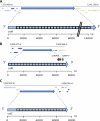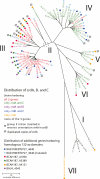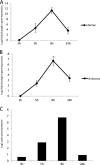Evolutionary history and functional characterization of three large genes involved in sporulation in Bacillus cereus group bacteria
- PMID: 21821775
- PMCID: PMC3187416
- DOI: 10.1128/JB.05309-11
Evolutionary history and functional characterization of three large genes involved in sporulation in Bacillus cereus group bacteria
Abstract
The Bacillus cereus group of bacteria is a group of closely related species that are of medical and economic relevance, including B. anthracis, B. cereus, and B. thuringiensis. Bacteria from the Bacillus cereus group encode three large, highly conserved genes of unknown function (named crdA, crdB, and crdC) that are composed of 16 to 35 copies of a repeated domain of 132 amino acids at the protein level. Bioinformatic analysis revealed that there is a phylogenetic bias in the genomic distribution of these genes and that strains harboring all three large genes mainly belong to cluster III of the B. cereus group phylogenetic tree. The evolutionary history of the three large genes implicates gain, loss, duplication, internal deletion, and lateral transfer. Furthermore, we show that the transcription of previously identified antisense open reading frames in crdB is simultaneously regulated with its host gene throughout the life cycle in vitro, with the highest expression being at the onset of sporulation. In B. anthracis, different combinations of double- and triple-knockout mutants of the three large genes displayed slower and less efficient sporulation processes than the parental strain. Altogether, the functional studies suggest an involvement of these three large genes in the sporulation process.
Figures




Similar articles
-
Diversity of the Rap-Phr quorum-sensing systems in the Bacillus cereus group.Curr Genet. 2019 Dec;65(6):1367-1381. doi: 10.1007/s00294-019-00993-9. Epub 2019 May 18. Curr Genet. 2019. PMID: 31104082
-
SpoVG is an important regulator of sporulation and affects biofilm formation by regulating Spo0A transcription in Bacillus cereus 0-9.BMC Microbiol. 2021 Jun 8;21(1):172. doi: 10.1186/s12866-021-02239-6. BMC Microbiol. 2021. PMID: 34102998 Free PMC article.
-
Interspersed DNA repeats bcr1-bcr18 of Bacillus cereus group bacteria form three distinct groups with different evolutionary and functional patterns.Mol Biol Evol. 2011 Feb;28(2):963-83. doi: 10.1093/molbev/msq269. Epub 2010 Oct 20. Mol Biol Evol. 2011. PMID: 20961964
-
Bacillus cereus spores and toxins - The potential role of biofilms.Food Microbiol. 2020 Sep;90:103493. doi: 10.1016/j.fm.2020.103493. Epub 2020 Mar 26. Food Microbiol. 2020. PMID: 32336372 Review.
-
The hidden lifestyles of Bacillus cereus and relatives.Environ Microbiol. 2003 Aug;5(8):631-40. doi: 10.1046/j.1462-2920.2003.00461.x. Environ Microbiol. 2003. PMID: 12871230 Review.
Cited by
-
Genomic Analysis of Bacillus sp. Strain B25, a Biocontrol Agent of Maize Pathogen Fusarium verticillioides.Curr Microbiol. 2018 Mar;75(3):247-255. doi: 10.1007/s00284-017-1372-1. Epub 2017 Oct 19. Curr Microbiol. 2018. PMID: 29051980
-
Survey of chimeric IStron elements in bacterial genomes: multiple molecular symbioses between group I intron ribozymes and DNA transposons.Nucleic Acids Res. 2014 Nov 10;42(20):12333-51. doi: 10.1093/nar/gku939. Epub 2014 Oct 16. Nucleic Acids Res. 2014. PMID: 25324310 Free PMC article.
-
Genomics of Clostridium taeniosporum, an organism which forms endospores with ribbon-like appendages.PLoS One. 2018 Jan 2;13(1):e0189673. doi: 10.1371/journal.pone.0189673. eCollection 2018. PLoS One. 2018. PMID: 29293521 Free PMC article.
-
Xenobiotic-metabolizing enzymes in Bacillus anthracis: molecular and functional analysis of a truncated arylamine N-acetyltransferase isozyme.Br J Pharmacol. 2017 Jul;174(14):2174-2182. doi: 10.1111/bph.13647. Epub 2016 Nov 12. Br J Pharmacol. 2017. PMID: 27846346 Free PMC article.
References
-
- Caillaud F., Trieu-Cuot P., Carlier C., Courvalin P. 1987. Nucleotide sequence of the kanamycin resistance determinant of the pneumococcal transposon Tn1545: evolutionary relationships and transcriptional analysis of aphA-3 genes. Mol. Gen. Genet. 207:509–513 - PubMed
Publication types
MeSH terms
Substances
LinkOut - more resources
Full Text Sources
Other Literature Sources
Molecular Biology Databases

